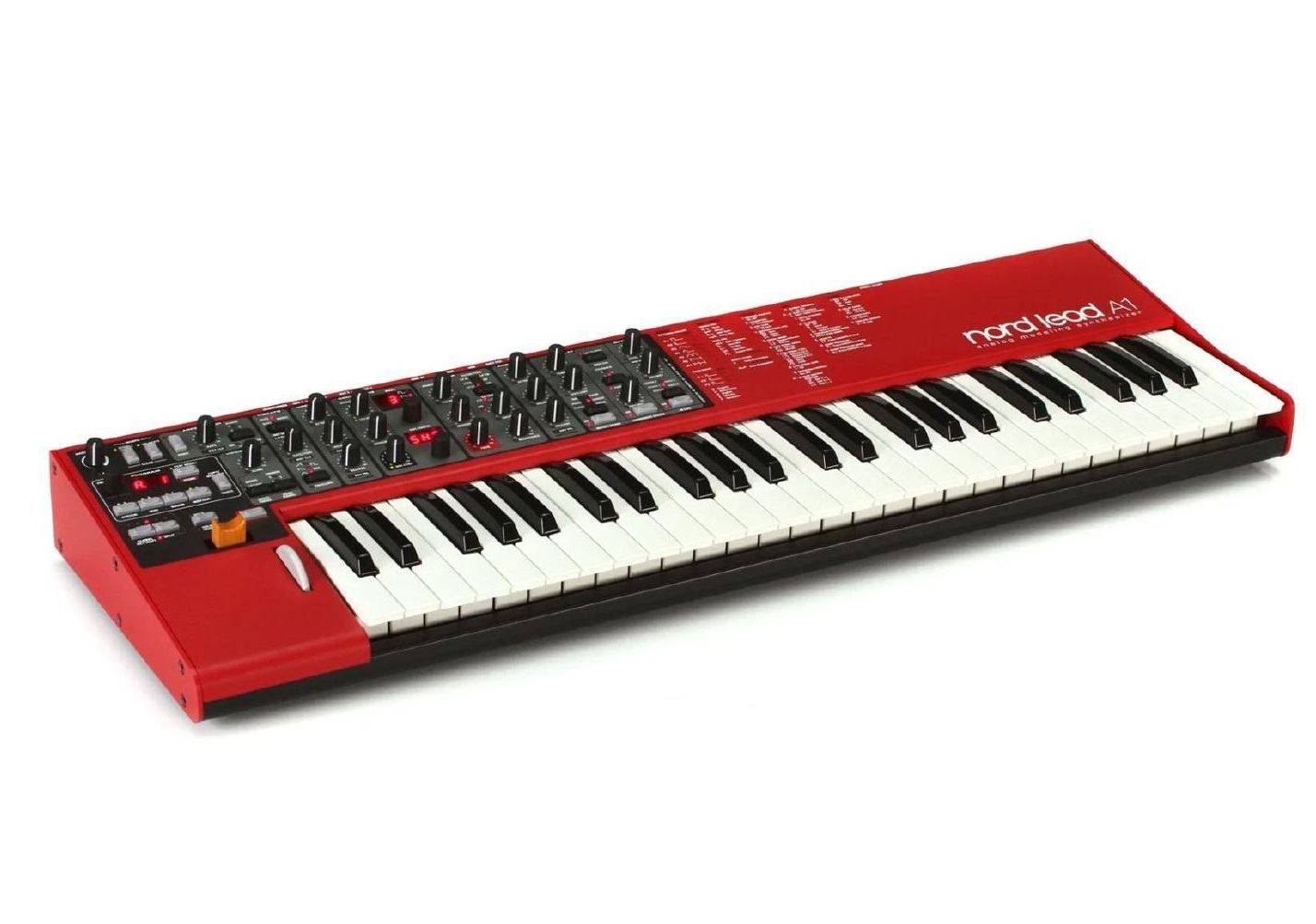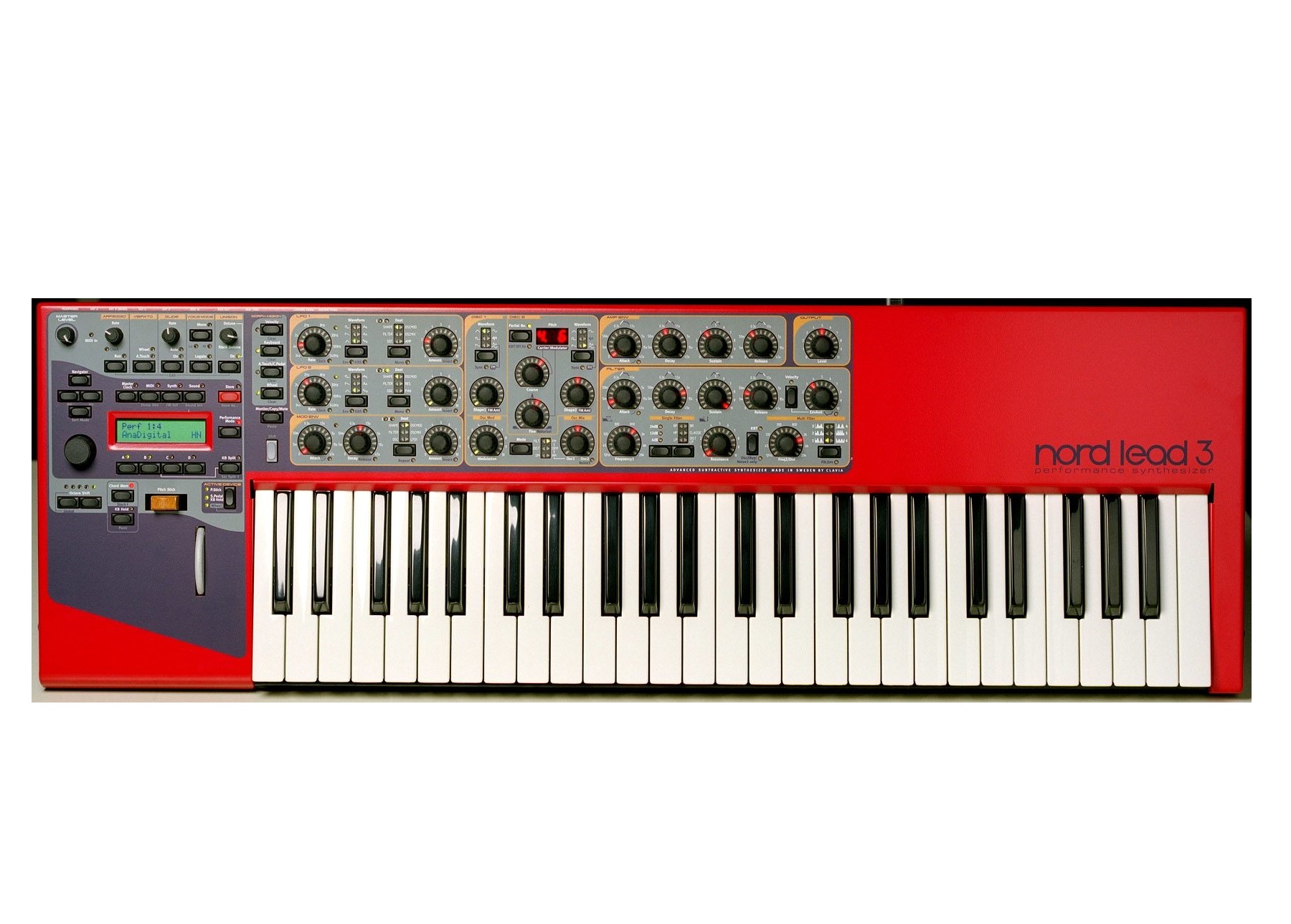Nord Lead
Electronic Instruments
Europe
Between 1901 and present
Video
The Nord Lead synthesizer is one of the most celebrated and influential synthesizers in the world of electronic music. Known for its powerful sound, unique construction, and versatility, it has been a crucial tool for musicians across genres.
Description of the Nord Lead
The Nord Lead is an analog modeling synthesizer produced by the Swedish company Clavia Digital Musical Instruments. Since its release in 1995, the Nord Lead has become renowned for its incredible sound, ease of use, and visually distinct red chassis. Known for its distinctive “lead” sound, it has served as a staple in the synthesizer world, offering flexibility in both studio environments and live performances. At its core, the Nord Lead is designed to emulate classic analog synthesizers. It combines the warmth of analog synthesis with the flexibility of modern digital technology, allowing users to create everything from classic retro sounds to cutting-edge sonic textures. The instrument is also celebrated for its user-friendly interface, which includes a wealth of knobs and buttons that let users tweak parameters in real time.
Type of Instrument
The Nord Lead is classified as a virtual analog synthesizer, meaning it uses digital technology to emulate the characteristics of traditional analog synths. The term “virtual analog” is used because, while it relies on digital components to produce sound, it attempts to replicate the behavior of analog circuitry, offering users the warmth and character associated with older synths but with the reliability and flexibility of modern electronics.
Despite being digital at its core, the Nord Lead uses a method known as subtractive synthesis, the same technique used in traditional analog synthesizers. This method involves shaping sound by filtering and modulating waveforms, a process that produces rich and evolving tones that are ideal for both melodic leads and atmospheric pads.
History of the Nord Lead
The Nord Lead has its origins in Sweden, where it was developed by Clavia Digital Musical Instruments, a company founded in the late 1980s by Mikael Carlsson. Clavia had already made a name for itself with the release of the Nord Electro, a keyboard that sought to emulate classic electric pianos and organs. However, the launch of the Nord Lead in 1995 marked a major leap forward for the company, as it moved into the world of synthesizers with a model that would eventually become legendary.
The instrument was born during the late 20th century, a period marked by the resurgence of analog-inspired digital synths. The mid-1990s were a time when music production was shifting toward more digitally driven methods, and there was a growing interest in instruments that could mimic the rich textures of analog synthesizers. The Nord Lead was one of the first to effectively capture the essence of analog sound while utilizing digital technology for greater precision and control. This synthesis of old and new marked the beginning of a new era in electronic music.
Clavia’s vision for the Nord Lead was to create a powerful yet intuitive instrument for live performances and studio use. The emphasis was on offering musicians a straightforward interface that could be used to quickly shape sounds on the fly, without delving too deeply into complex programming. This focus on accessibility and hands-on control made the Nord Lead an instant favorite among musicians and producers.
Construction
The construction of the Nord Lead is part of what makes it stand out in the world of synthesizers. One of the first things people notice about the Nord Lead is its striking bright red color, which has become a signature aesthetic of the Nord brand. The synth features a robust metal casing that is designed for durability, making it ideal for both studio use and live performances. The instrument is relatively lightweight, considering its solid build, making it portable without compromising on quality.
The front panel of the Nord Lead is where users interact with the instrument. It is covered in a series of knobs, buttons, and sliders, each of which controls a specific parameter of sound creation or manipulation. The layout of the panel is designed to be both intuitive and straightforward, ensuring that musicians can make adjustments quickly during a performance. Inside, the Nord Lead features a digital signal processor (DSP), which is responsible for generating and manipulating sound. The use of DSP technology allows the instrument to simulate analog sound circuits, providing the warmth of analog tones without the inherent instability and maintenance issues of true analog circuits. This gives the Nord Lead both the reliability of modern technology and the desirable characteristics of vintage analog synths.
Types of Nord Lead
Over the years, Clavia has released several versions of the Nord Lead, each improving upon its predecessor in terms of features, sound capabilities, and performance. The most notable types of Nord Lead include:
Nord Lead 1 (1995): The original model of the Nord Lead featured a powerful set of digital oscillators and filters, delivering classic analog sounds through virtual analog synthesis. It quickly gained popularity among musicians for its ability to recreate the warmth and richness of older analog synths, but with the added benefits of digital precision.
Nord Lead 2 (1997): The second version of the Nord Lead introduced enhanced sound quality and more powerful features, including increased polyphony, more waveforms, and greater modulation capabilities. The Lead 2 solidified the Nord Lead’s reputation as a performance-oriented synthesizer, with a sleek interface that allowed users to manipulate sound quickly during live shows.
Nord Lead 3 (2001): The third iteration of the Nord Lead marked a significant leap forward in terms of sound design. It introduced a more complex set of modulation options, including a new, highly flexible filter section and a more sophisticated arpeggiator. The Nord Lead 3 also featured an advanced user interface, with a large LCD screen for more precise control over the instrument’s parameters.
Nord Lead 4 (2013): The Nord Lead 4 introduced more polyphony and advanced features, including an enhanced effects section, an improved user interface, and deeper modulation possibilities. It also came with a dual-synth architecture, which allowed users to layer two different sounds at the same time. This version further cemented the Nord Lead’s place as a leading synthesizer in both live performance and studio settings.
Each version of the Nord Lead has built upon the legacy of its predecessors while adapting to the changing needs of musicians. Despite the advancements in technology, the Nord Lead has always maintained its commitment to simplicity, ease of use, and a focus on producing high-quality sounds.
Features of the Nord Lead
The Nord Lead is packed with features that make it a powerful tool for musicians. Some of the key features include:
Virtual Analog Synthesis: The Nord Lead uses virtual analog synthesis to emulate classic analog sounds. This allows musicians to create a wide range of sounds, from lush pads to sharp leads, with the warmth and depth that is characteristic of analog synths.
Hands-On Control: One of the standout features of the Nord Lead is its user-friendly interface. The synthesizer is designed to be manipulated in real-time, with numerous knobs, sliders, and buttons that allow musicians to adjust the sound instantly. This makes it ideal for live performances, where quick adjustments to sound are often necessary.
Multiple Oscillators: The Nord Lead offers a range of oscillator types, allowing users to create a variety of sounds. From saw waves and square waves to more complex waveforms, the oscillators provide a rich sonic palette.
Advanced Modulation: The Nord Lead offers extensive modulation capabilities, including LFOs (Low-Frequency Oscillators), envelopes, and an array of modulation sources and destinations. This flexibility allows users to create dynamic and evolving sounds.
Built-in Effects: The Nord Lead includes a range of built-in effects, such as reverb, delay, chorus, and distortion. These effects add depth and dimension to the sounds, making it a versatile tool for both studio production and live performances.
Polyphony: The polyphony of the Nord Lead allows musicians to play multiple notes simultaneously, creating rich chords and complex harmonic structures. The number of voices varies depending on the version of the Nord Lead, with newer models offering higher polyphony.
Sound Production
Sound production in the Nord Lead is based on subtractive synthesis, where the sound is shaped by filtering and modulating waveforms. The synth offers multiple oscillators with different waveforms, allowing users to craft a variety of sounds by adjusting parameters such as pitch, filter type, and resonance. The addition of modulation sources, such as LFOs and envelopes, provides even more complexity, enabling the creation of evolving sounds that are perfect for a wide range of musical styles. The Nord Lead’s filters are key to its sound design, offering various types, including low-pass filters, high-pass filters, and band-pass filters. These filters allow users to shape the timbre of their sounds, cutting off certain frequencies to create everything from smooth, warm tones to sharp, cutting leads. The combination of oscillators and filters gives the Nord Lead its signature analog sound, which is both rich and flexible.
Playing Methods
The Nord Lead can be played in a variety of ways, depending on the style of music and the performance needs of the musician. Keyboards are the most common method of playing the Nord Lead, as the synthesizer is equipped with a traditional 61-key or 49-key keyboard, depending on the model. These keyboards are highly responsive, with velocity-sensitive keys that respond to the intensity of a player’s touch. In addition to the keyboard, the Nord Lead can be integrated with MIDI controllers to expand its control options. These controllers allow for more precise manipulation of sound parameters, including modulation wheels, expression pedals, and foot switches.
Roles in Music
The Nord Lead has had a significant role in various music genres since its release. It has been used extensively in electronic music, where its ability to produce cutting-edge sounds has made it a go-to instrument for producers and live performers alike. The synthesizer has also played a key role in genres like rock, pop, and new wave, where it has contributed to iconic sounds in both the studio and on stage. One of the key roles of the Nord Lead in music is as a lead instrument. Its rich and vibrant tones make it ideal for playing melodic lines, and its versatility allows it to cut through the mix in both live and recorded settings. In addition to its lead capabilities, the Nord Lead is also used for creating ambient textures, atmospheric pads, and bass sounds, making it an essential tool for musicians looking to create full, dynamic compositions. Overall, the Nord Lead has solidified its place as one of the most important synthesizers in modern music, offering unparalleled versatility, reliability, and sound quality.
This comprehensive look at the Nord Lead synthesizer highlights the many facets that make it a beloved tool for musicians and producers alike. From its rich history and innovative features to its role in shaping the sound of modern music, the Nord Lead remains an indispensable instrument in the world of electronic sound creation.
FAQ
What is the Nord Lead, and what is its role in music production?
The Nord Lead is a highly-regarded synthesizer, known for its analog-style sounds. It plays a major role in electronic music production by offering versatile sound design options. Artists use it for rich bass, atmospheric pads, and dynamic leads.
How has the Nord Lead influenced contemporary music artists?
The Nord Lead has been integral to many contemporary artists, particularly in electronic, house, and pop genres. Its distinctive sounds are featured in countless tracks, providing a unique, crisp quality to synth-heavy compositions.
What makes the Nord Lead stand out compared to other synthesizers?
The Nord Lead stands out for its ease of use, high-quality sound, and exceptional build. It offers powerful digital oscillators combined with an intuitive interface, making it a favorite among both beginners and professionals in music production.
 Links
Links
References
Other Instrument
Categories



















